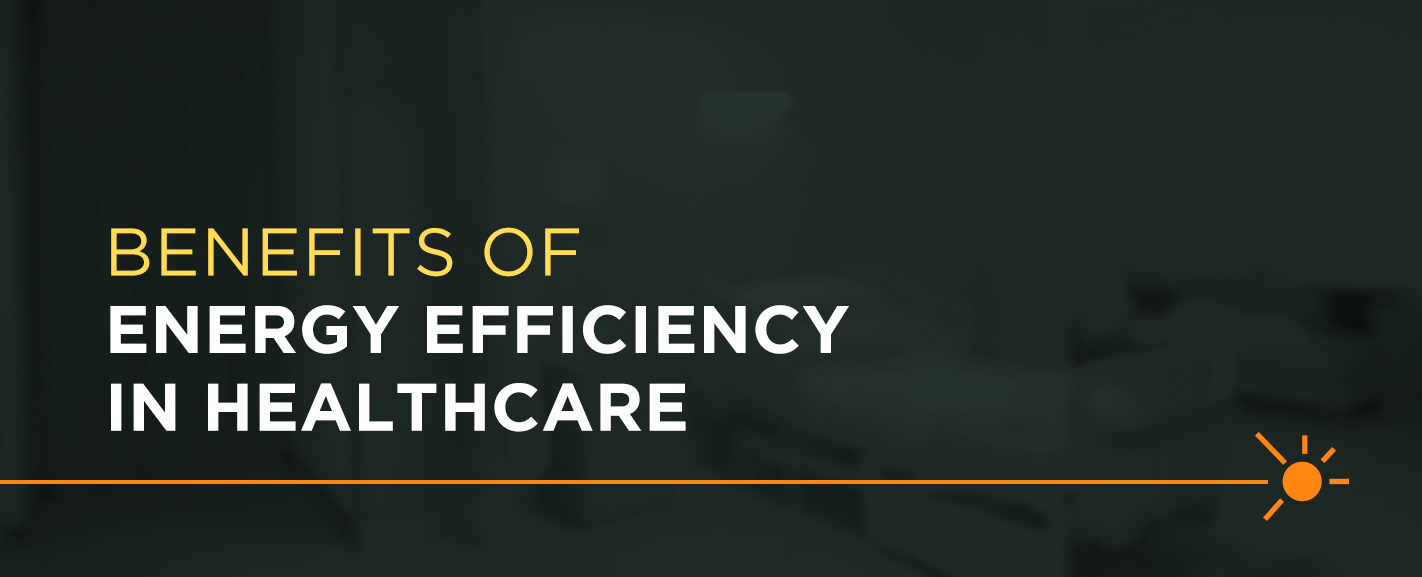
Hospitals spend thousands of dollars per bed in electricity each year. With such a high operating cost, it’s no wonder many hospitals are seeking to conserve energy. Energy conservation in hospitals takes skill and coordination, but the results can save money and even help patient outcomes and their recovery process.
What Are Common Energy Efficiency Problems in Healthcare?
The healthcare industry is complex. In pursuing the noble goal of saving lives, hospitals have unique needs. For an industry that uses far more energy than most, it can be difficult to get a healthcare facility running efficiently. Several factors make it challenging to achieve energy-efficient operations in a hospital setting, including:
1. Operating 24/7/365
Patients need around-the-clock care, and life-saving equipment needs constant power generation. While most buildings can be more energy efficient by limiting usage after hours, there is no after-hours time for healthcare facilities.
Plus, 24-hour operation can delay technology upgrades. Any work on energy conservation systems in the building must be carefully coordinated so it doesn’t interrupt daily activities or take place in a patient’s room. Even work in an unoccupied patient or care room must be coordinated with staff and facility managers.
2. Health and Safety Concerns
When embarking on energy conservation initiatives, hospital facility managers and energy partners must be keenly aware of the sensitive environment. The health and safety of patients, staff, visitors, and others must be a central consideration throughout every project. The extra precautions required can make energy conservation projects more time-consuming and costly.
Contamination can be a safety concern that delays new energy projects. Energy contractors need to be creative when finding workspaces and storage areas. They must work hand-in-hand with staff so they don’t impact patient care. Energy consultants need to work with a hospital’s Infection Control Department to keep patients safe. A common step is to ensure the team has received flu shots and is properly vaccinated.
Air quality is another crucial concern. Construction projects must use containment carts to collect dust while working, and partitions may be used to separate areas where work is ongoing. Workers must also take care not to block access to critical areas or hospital equipment.
In addition, lighting can have a direct impact on safety long after a project is complete. Facility staff and patients travel between the hospital and their vehicles at all hours of the day and night. It is necessary to have appropriate lighting in place so everyone feels safe entering and exiting the facility no matter what time it is.
3. Expanding Facilities Over Time
Many well-established hospitals have an ad-hoc layout. As facilities expand, new wings extend from the original building. When this happens, newer areas often have different energy infrastructure than the older areas.
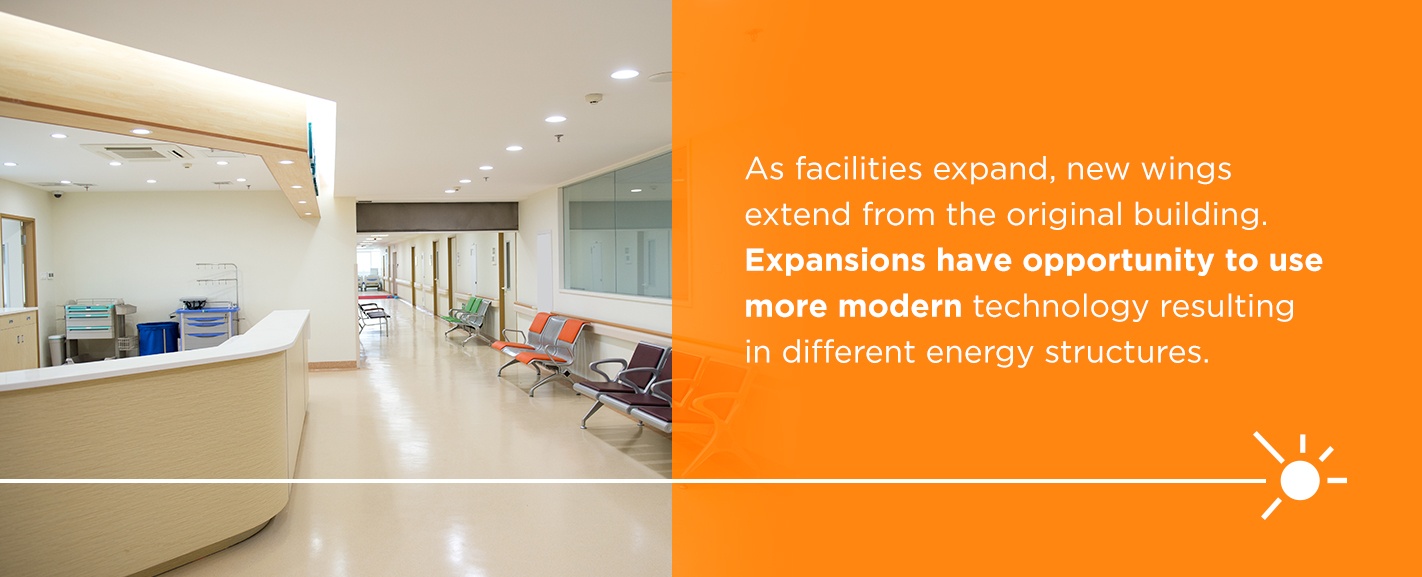
Older areas may have outdated, less efficient lighting and HVAC systems. New spaces may have better insulation and layouts designed to reduce energy consumption, while older areas of the building may be less efficient.
When a building has a disjointed energy framework, it can be harder to make it operate at peak efficiency. When new sections are connected to older ones, they may use the same older HVAC system, for instance. Taking full advantage of the energy-efficient features of newer wings may require updating older spaces as well, which increases the costs of renovation projects.
4. Rising Energy Costs
The rising cost of energy is a concern for every business. Energy prices naturally fluctuate due to market conditions. Hospitals have sophisticated buildings, high rates of product procurement, and high transportation costs. These factors make the healthcare industry more susceptible to spikes in energy costs. They also make limiting dependence on resources a top priority for hospital facility managers.
Learn About Our Energy Solutions
How Will Energy Efficiency Benefit Healthcare Facilities?
Choosing to become more energy-efficient offers a whole host of benefits for the healthcare sector. Most convincing is the savings from reduced energy usage each month. Improving energy conservation in healthcare facilities such as hospitals can also simplify facility management and help the environment. Increasing energy efficiency can help healthcare facilities to:
- Identify Low and No-Cost Savings
- Make Low-Risk Investments
- Effectively Integrate Systems
- Create a More Comfortable Environment
- Offer a Professional and Modern Appearance
- Discover New Build Opportunities
- Reduce Environmental Impact
1. Identify Low and No-Cost Savings
As you develop a facility energy conservation plan, you’ll uncover numerous potential cost savings, including some which require only a relatively low upfront investment or no upfront investment at all. Some of these potential upgrades include:
- Replacing exit signs with LED signs: Most exit signs use 36 Watts of electricity, while LED exit signs use only five. For a typical 600-bed hospital with 300 exit signs, retrofitting LED signage will result in $14,755 in savings each year. A hospital would earn back the initial investment in 1.15 years.
- Replacing light fixtures with LEDs: Retrofitting a building with LEDs is one of the best investments in energy efficiency a hospital can make. A 12 Watt energy-efficient LED light bulb can save between 72 and 80 percent of the energy costs of a traditional light bulb. While an incandescent bulb will last for about 1,000 hours, an LED will last 25,000 hours. So, LED lighting will save a hospital thousands each year in energy costs, and will even cost less to replace. LEDs also provide an exceptionally bright light, which helps to illuminate entrances and exits, parking lots, and garages, enhancing staff and patient safety.
- Limiting air changes in the OR: When an operating room is in use, it must have at least 20 air changes per hour. Keeping this going 24 hours a day can rack up quite the energy bill. One hospital network in Ohio projected savings of $2 million per year from reducing air changes to six per hour when the OR is not in use.
- Using data analytics to uncover energy savings: Data-driven energy optimization solutions, like those from EnergyIQ, make it easy to identify the most cost-effective energy management upgrades for your facility. EnergyIQ provides you with building data analytics and savings opportunities organized by value, so your maintenance team can tackle the most beneficial projects first. In addition, SitelogIQ can provide you with as much energy engineering support as you need.

2. Make Low-Risk Investments
Low-risk investments in energy efficiency in hospitals can reduce operating costs. Upgrades to energy-efficient technology generally have a short projected payoff period. While they may cost more initially, they result in measurable savings in energy costs over time. Here are some investments in energy efficiency that pay for themselves in the long term:
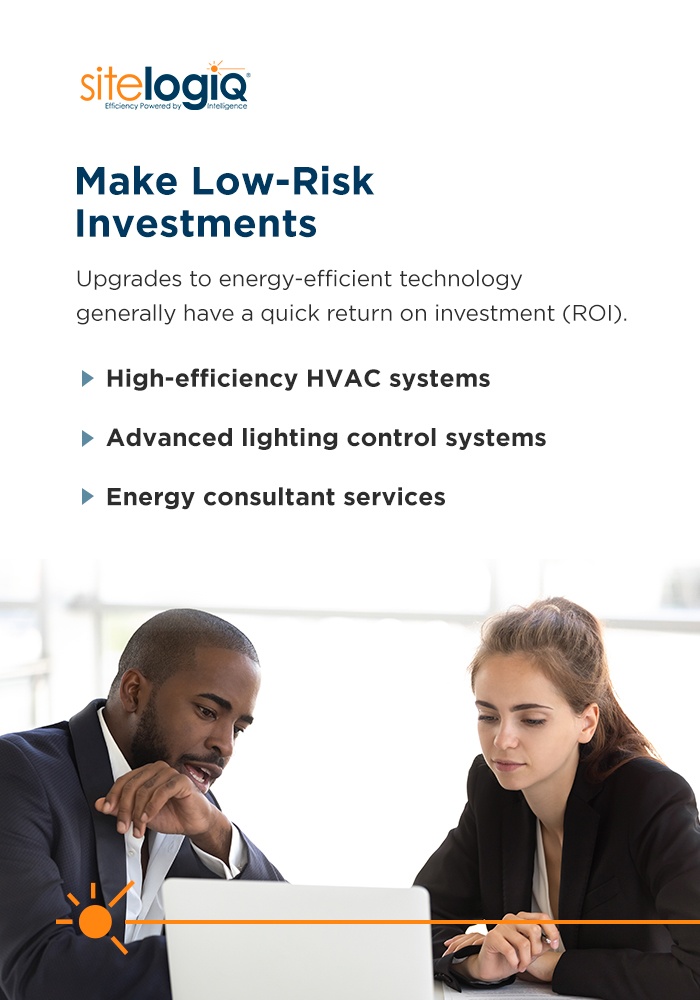
- High-efficiency HVAC systems: Heating, ventilation, and air conditioning use significant energy. They are some of the biggest costs associated with commercial energy use, and the healthcare sector is no exception. In such a sensitive environment, it may not always be possible to turn the heat or the AC down to save on costs. Instead, hospitals should consider investing in energy-efficient systems. ENERGY STAR-rated heating and cooling units will run more efficiently, saving money in the long run.
- Advanced lighting control systems: LED lighting in hospitals offers many advantages. A smart lighting system allows a healthcare facility to reduce electricity consumption through hours of lighting operation and lighting intensity. A study by Lawrence Berkeley National Laboratory found that lighting control systems result in 24 to 38 percent energy savings.
- Energy consultant services: Energy planning is one of the most effective ways to increase efficiency. An energy audit can help you find areas of improvement and get the most out of all your technology. An energy consultant can conduct an energy audit, design energy-efficient facility improvements, install new technologies, create an energy management system, and more to help you reduce your energy usage over time.
3. Effectively Integrate Systems
Hospitals sometimes have disparate energy systems. Separate wings and even rooms on the same floor can have a different framework, depending on when they were built or renovated. Non-integrated systems tend to limit energy efficiency and make life more complicated for hospital facility managers.
While one area might have a brand new, energy-efficient HVAC system and LED lights, the old wing might run on out-of-date equipment. As a facility manager, you might be navigating between several building management systems to keep everything running.
Taking on an energy management project is a chance to upgrade technology and integrate these systems. Integrated systems use less energy and simplify management. If you’re implementing smart lighting controls, it may also be an excellent opportunity to incorporate them with HVAC system controls. Doing so can give nurses and patients complete control over comfort, with the ability to adjust lighting and temperature on a single interface.
4. Create a More Comfortable Environment
Employing energy-saving initiatives can have some surprising benefits for patients, staff, and visitors. Advanced lighting systems and programmable HVAC systems can make patient rooms and waiting areas more comfortable. To create a more comfortable environment, consider:
- Smart lighting controls: Energy efficiency upgrades can improve patient care. LED lights can be programmed to mimic daylight cycles better, and dynamic lighting can have a positive impact on patients’ sleep and circadian rhythms. Harsh or inadequate lighting can lead to headaches, eyestrain, or fatigue. The Journal of Biosciences and Medicines recommends LEDs because they eliminate these ailments — they also provide better visual comfort because LED lights do not flicker.
- Natural lighting: Another energy conservation technique that creates more comfort for patients and visitors is natural lighting. Designing healthcare buildings and rooms that let in more sunlight can save energy by reducing the need to turn on lights. Natural lighting can also work wonders for patient recovery. Studies have shown that patients exposed to natural light experience less stress and pain. They also take 22 percent less analgesic pain medication per hour. You can also install LED lighting system that mimics natural lighting to get the benefits of natural light, as well as the reliability and consistent availability of LEDs.
- Programmable HVAC: Programming the heating and cooling systems to ramp down when rooms are not in use can also have a significant impact on comfort. Most waiting rooms and other visitor areas go unoccupied after visitation hours end. Turning down the climate controls during these times helps a hospital save on energy costs. Programming these systems to ramp up when visiting hours begin means guests walk into waiting rooms that are a comfortable temperature. Allowing patients and nurses to adjust temperatures to their comfort can also reduce energy costs.
5. Offer a Professional and Modern Appearance
Another one of the benefits of energy efficiency in hospitals is better control over the lighting. Advanced lighting can result in a more modern-looking facility. LED lighting systems come in a variety of warmth and brightness settings. Advanced lighting controls allow hospitals to customize lighting to create a more inviting space.
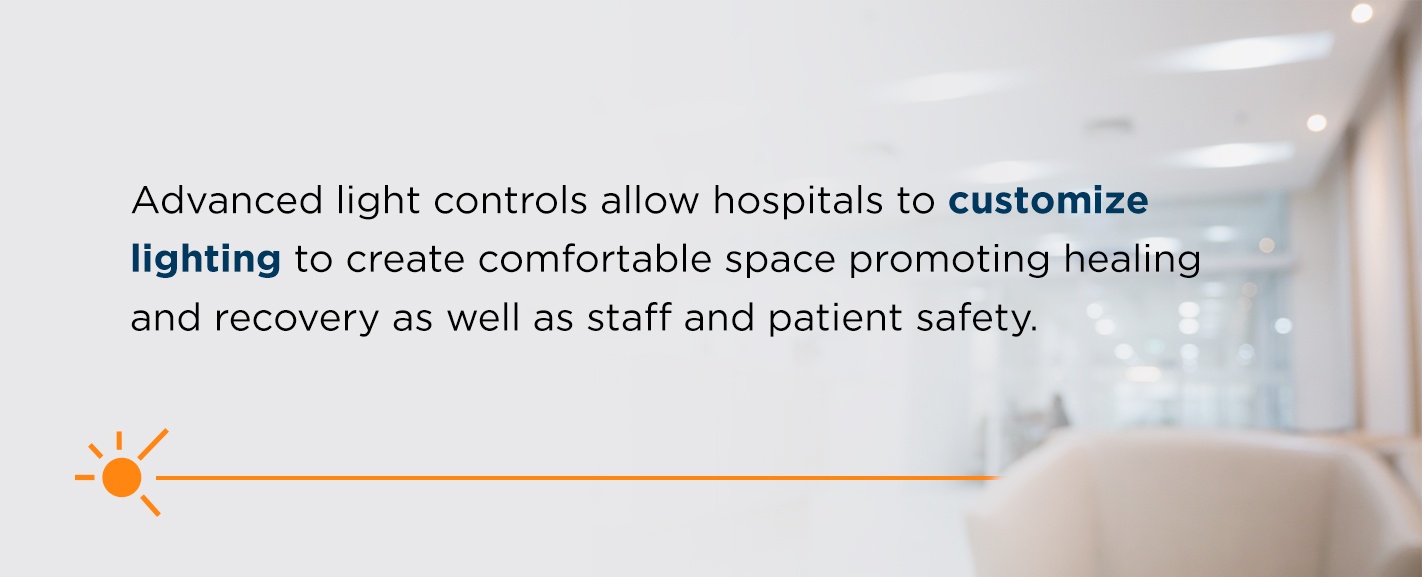
Many LED lights, integrated with smart lighting controls, enable users to make the light warmer or cooler, depending on their preference. LEDs can integrate color tuning, allowing them to mimic natural lighting, encourage a sense of calm or promote alertness. They can also be dimmed to create less harsh lighting.
6. Discover New Build Opportunities
When you identify ways to reduce energy consumption, you’ll likely begin upgrading your hospital’s infrastructure. A typical step many facilities take is updating the insulation. Especially if the building is older, some new insulation can completely transform a space. With new insulation, the building will retain more heat in the winter and keep out more hot air in the summer. This tactic saves on heating and cooling costs and creates a more comfortable environment that can help patients heal.
A hospital can avoid the challenge of 24-hour operation by building energy-efficient buildings from the start. With all the challenges that come with retrofitting a hospital with energy-efficient technology, the best time to up a building’s energy efficiency is as you’re building it. Upgrading the building’s current infrastructure can create the opportunity to expand your facility. Meeting energy goals can also open up funds to build additions or a new hospital altogether.
Some hospital networks take on smart energy efficiency goals during the construction of new buildings. Green hospital buildings usually cost the same amount to build and save a great deal on maintenance costs long-term.
7. Reduce Environmental Impact
The healthcare industry accounts for 9.8 percent of U.S. greenhouse gas generation. Hospitals use an average of 600,000 BTUs of energy per building annually. That amount of energy is more than almost any other type of building in the country. As one of the largest energy consumers in the country, energy conservation in healthcare has a hidden environmental impact we don’t often consider.
Energy usage and emissions can cause adverse health effects. Most significantly, air pollution can cause or worsen asthma and other complications. Hospitals save lives and make a great effort to create a healthier world. Since doctors commit to “do no harm,” the healthcare sector has also prioritized sustainability.
Conserving energy can limit a hospital’s dependence on pollution-generating energy sources. An overwhelming majority of healthcare facilities have committed to reducing their impact on the environment through better energy consumption. According to one survey, 87 percent of respondents in the healthcare industry has plans to electrify space or water heating, which would reduce fossil fuel use. The industry also has a high concentration of renewable energy goals with a deadline between 2020 and 2025.
With so many healthcare professionals looking to reduce their impact on the environment, energy efficiency is vital. Integrating solar panels is another strategy that can reduce energy costs over time. Protecting energy from going to waste and finding green energy solutions lets hospitals run cleaner and aid the environment. Commitment to energy efficiency can make the whole planet healthier.
Learn About Our Energy Solutions
Trust SitelogIQ With Your Healthcare Facility’s Energy Needs
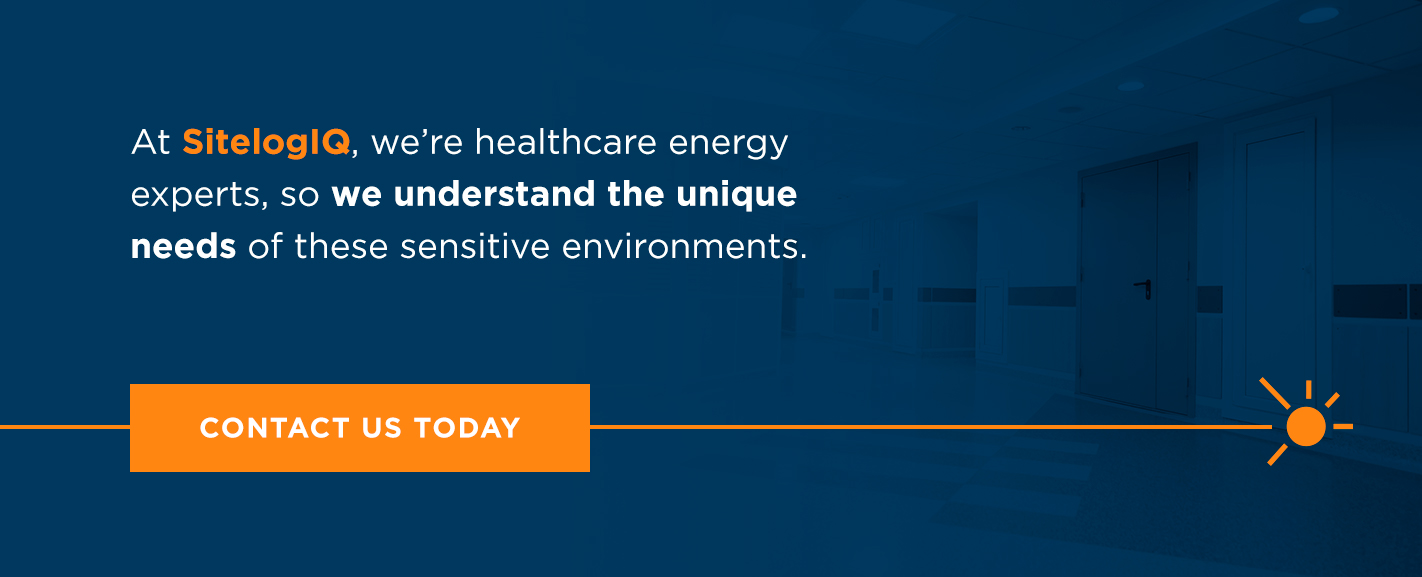
The healthcare industry is complicated. Between concerns for health and safety and other constraints, it’s essential to work with an experienced energy management and efficiency team. At SitelogIQ, we’ve worked with many hospitals, so we understand the unique needs of these sensitive environments. We know your biggest concern is providing the best possible care for patients, so we take care to work around the schedule of nurses and doctors. Our case study of Zambarano Memorial Hospital shows how we provide cost-effective solutions for healthcare facilities like yours.
Whether you are building a new facility or are looking to reduce the energy costs of an existing one, SitelogIQ is here to help with energy-efficient design solutions. We can also provide you with an energy audit, construction or design, and ongoing energy management support. If you’re ready to make your energy usage more efficient, reach out to us today.


